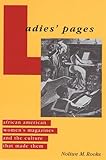Ladies' Pages : African American Women's Magazines and the Culture That Made Them / Noliwe M. Rooks.
Material type: TextPublisher: New Brunswick, NJ : Rutgers University Press, [2004]Copyright date: ©2004Description: 1 online resource (224 p.)Content type:
TextPublisher: New Brunswick, NJ : Rutgers University Press, [2004]Copyright date: ©2004Description: 1 online resource (224 p.)Content type: - 9780813534244
- 9780813542522
- African American periodicals -- History -- 19th century
- African American periodicals -- History -- 20th century
- African American periodicals -- History -- 19th century
- African American periodicals -- History -- 20th century
- Women's periodicals, American -- History -- 19th century
- Women's periodicals, American -- History -- 20th century
- Women's periodicals, American -- History -- 19th century
- Women's periodicals, American -- History -- 20th century
- SOCIAL SCIENCE / General
- 051/.082 22
- PN4882.5 .R66 2004eb
- online - DeGruyter
- Issued also in print.
| Item type | Current library | Call number | URL | Status | Notes | Barcode | |
|---|---|---|---|---|---|---|---|
 eBook
eBook
|
Biblioteca "Angelicum" Pont. Univ. S.Tommaso d'Aquino Nuvola online | online - DeGruyter (Browse shelf(Opens below)) | Online access | Not for loan (Accesso limitato) | Accesso per gli utenti autorizzati / Access for authorized users | (dgr)9780813542522 |
Browsing Biblioteca "Angelicum" Pont. Univ. S.Tommaso d'Aquino shelves, Shelving location: Nuvola online Close shelf browser (Hides shelf browser)

|

|

|

|

|

|

|
||
| online - DeGruyter Global Currents : Media and Technology Now / | online - DeGruyter Happy Days and Wonder Years : The Fifties and the Sixties in Contemporary Cultural Politics / | online - DeGruyter Hearts of Darkness : White Women Write Race / | online - DeGruyter Ladies' Pages : African American Women's Magazines and the Culture That Made Them / | online - DeGruyter New Perspectives on Environmental Justice : Gender, Sexuality, and Activism / | online - DeGruyter Sweated Work, Weak Bodies : Anti-Sweatshop Campaigns and Languages of Labor / | online - DeGruyter Sweatshop : The History of an American Idea / |
Frontmatter -- Contents -- List of Illustrations -- Acknowledgments -- 1. Scattered Pages: Magazines, Sex, and the Culture of Migration -- 2. Refashioning Rape: Ringwood's Afro-American Journal of Fashion -- 3. To Make a Lady Black and Bid Her Sing: Clothes, Class, and Color -- 4. "Colored Faces Looking Out of Fashion Plates.Well!": Twentieth-Century Fashion,Migration, and Urbanization -- 5. No Place Like Home: Domesticity, Domestic Work, and Consumerism -- 6. Urban Confessions and Tan Fantasies: The Commodification of Marriage and Sexual Desire in African American Magazine Fiction -- 7. But Is It Black and Female?: Essence,O, and American Magazine Publishing -- Notes -- Selected Bibliography -- Index -- About the Author
restricted access online access with authorization star
http://purl.org/coar/access_right/c_16ec
Beginning in the late nineteenth century, mainstream magazines established ideal images of white female culture, while comparable African American periodicals were cast among the shadows. Noliwe M. Rooks's Ladies' Pages sheds light on the most influential African American women's magazines--Ringwood's Afro-American Journal of Fashion, Half-Century Magazine for the Colored Homemaker, Tan Confessions, Essence, and O, the Oprah Magazine--and their little-known success in shaping the lives of black women. Ladies' Pages demonstrates how these rare and thought-provoking publications contributed to the development of African American culture and the ways in which they in turn reflect important historical changes in black communities. What African American women wore, bought, consumed, read, cooked, and did at home with their families were all fair game, and each of the magazines offered copious amounts of advice about what such choices could and did mean. At the same time, these periodicals helped African American women to find work and to develop a strong communications network. Rooks reveals in detail how these publications contributed to the concepts of black sexual identity, rape, migration, urbanization, fashion, domesticity, consumerism, and education. Her book is essential reading for everyone interested in the history and culture of African Americans.
Issued also in print.
Mode of access: Internet via World Wide Web.
In English.
Description based on online resource; title from PDF title page (publisher's Web site, viewed 30. Aug 2021)


